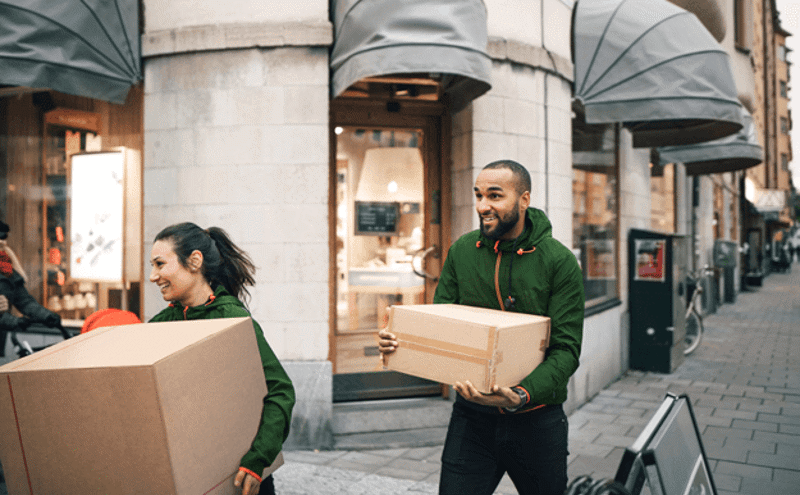Logistics and supply chain trends in the retail space accelerated throughout 2020, and while the huge increase in e-commerce might be the most talked-about development, the pandemic has also brought about the transformation of the brick-and-mortar store into a micro fulfillment center. Creating a new fulfillment strategy or embracing any other current trends in the retail logistics arena, requires collaboration with a supply chain technology provider or, in some cases, the implementation of a robust intermodal transportation management system (TMS).
Bill Thayer, co-founder of Fillogic, explained during a panel at the NRF 2021 Chapter 1 virtual conference that this idea was bandied about in the past, but retailers put it near the bottom of a long list of priorities. COVID changed all that.
“Everybody is more focused on, ‘We need to empower our physical location to be much more efficient,” he told the panel, which also featured Uber Direct’s Erik Logerquist and Stephen Yalof, president and COO of Tanger Outlet Center.
For true empowerment, adjustments are necessary. While the physical stores were not constructed with fulfillment in mind, shifts can be made to create new durable links in the supply chain, connecting transportation providers to a new location that, in many cases, is closer to the end consumer. Using these physical assets creates untold value in the supply chain, especially in a market where, he said, freight isn’t getting any cheaper due to the increasing costs of assets, among other things.
“If you can tighten those windows up and utilize these physical buildings to provide more logistics services, you just made the whole value chain more efficient,” he said.
Consumers continued to move toward online retail experiences in 2020, with panelists citing IBM research that found the pandemic sped up the complete movement to e-commerce by five years; McKinsey & Company, they said, measured 10 years of e-commerce growth in nine months. This trend could also be measured by the lack of activity around in-store shopping during Black Friday and the holiday shopping season.
FedEx and other parcel carriers have already started to feel the impact.
“There is now tons of pressure on these overworked parcel networks given the e-commerce boom,” Thayer said.
Beyond the logistics of shipping retail goods to consumers and the changing distribution models, consumer behavior has also shifted. Yalof noted that shopping patterns had begun to evolve before the pandemic, but that, once again, coronavirus safety procedures sped up the trend. Yalof said that new programs like curbside pickup and virtual shopping aren’t going away.
“It makes for a much more purposeful shopping visit,” he said.
To keep pace with these retail trends, shippers should consider engaging a supply chain technology partner or a TMS provider.
Logerquist said that while retailers in the past have wanted to keep up with Amazon Prime, the quest for parity in shipping and customer service became “existential needs.” Partnering with outside providers to successfully navigate these new realities is necessary, specifically because logistics programs around things like last-mile deliveries take a tremendous amount of infrastructure. Transparency is also an important step in this process.
“Not only do consumers want things on demand, they want to be informed every step of that journey,” he said.
Returns process. It’s still a process full of friction for consumers
“There’s a big opportunity to bring that level of service and transparency to reverse logistics.”
Tracking courier in real-time. Consumers have wanted that and B2B clients do as well.
While Logerquist thinks there’s a big opportunity in the return-logistics space — a process he said is full of friction — he’s increasingly excited about handing more control over the shipping experience to consumers. Instead of providing standard shipping options, he said some retailers are starting to give customers an option to Uber to the store to pick up their goods.
“What we’ve found is brands are very excited about this. They want to drive the incremental foot traffic, they want to drive the basket size, so we’ve seen really positive results when retailers provide more choice to their consumers,” he said.
In the end, sea changes in retail logistics require purposeful, planned collaboration with trusted and reliable supply chain partners. With collaboration, creating an adaptable, agile retail supply chain that can easily react, or even anticipate, future disruptions becomes that much easier.
“So many retailers, property owners, logistics providers, they’re all striving to work together,” Thayer said. “They’re democratizing the logistics process, which is what has been missing for the last 20 years.”
Blume Logistics provides supply chain execution technology solutions for procure-to-pay and order-to-cash processes, enabling collaboration among buyer, supplier and logistics providers. With orchestration, all trading partners are in sync and benefit from more effective tactical planning and execution, identifying opportunities and exceptions while supplying recommendations. Analytics support carrier and supplier score carding, KPI’s and dashboards. Blume’s intermodal transportation management system enables automated transportation management and execution across ALL modes of transport, routes and carriers; dynamic corrections to each user’s transportation plan and associated execution; and access to an extensive network of carriers, ensuring transportation capacity is always available.
contact us
Contact Us

